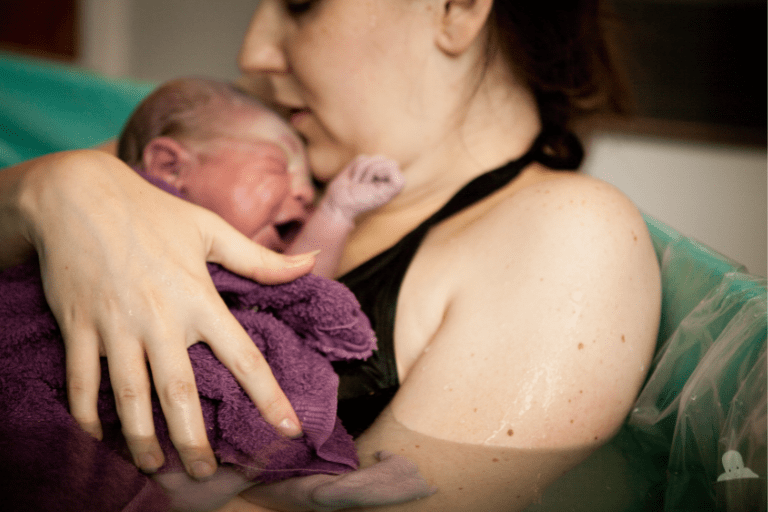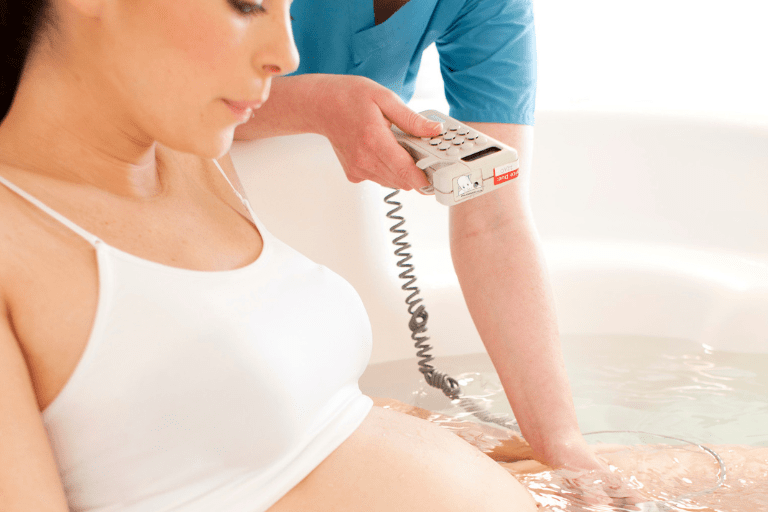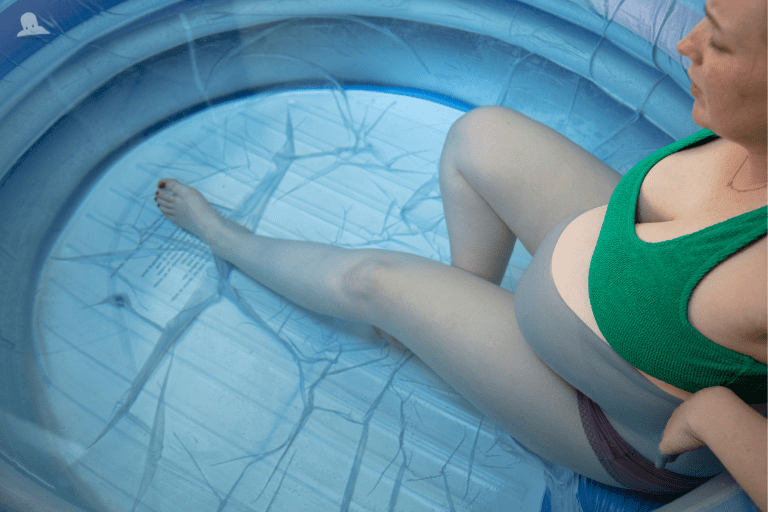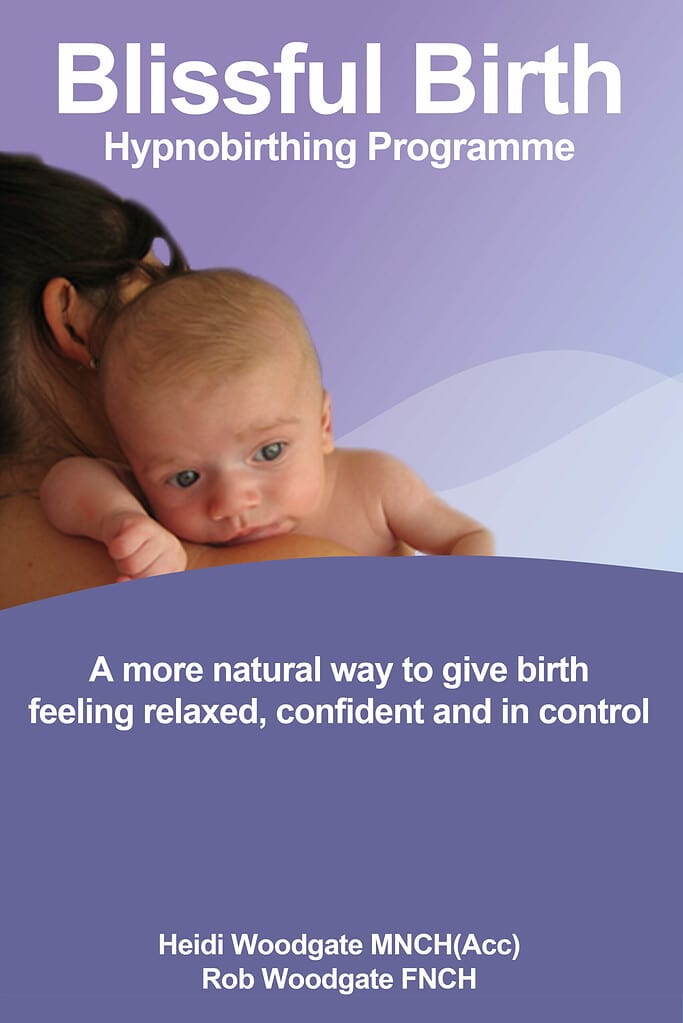As you prepare for the arrival of your little one, you may be wondering about your options for giving birth.
One option that has become increasingly popular in recent years is water birth. This approach involves giving birth in pool or in a birthing tub, and many women who have experienced it swear by its benefits.
Perhaps you’re curious about whether water birth might be right for you, or maybe you’ve already decided to give it a try. Either way, it’s important to have all the information you need to make an informed decision.
In this article, we’ll take a closer look at the pros and cons of water births, as well as the potential benefits of combining this approach with hypnobirthing techniques.
By the end, you’ll better understand whether a water birth might be a good fit for you and your baby.
Table of Contents
- Benefits Of Water Birth
- Water Birth Risks and Complications
- How Painful Is A Natural Water Birth?
- Can You Have A Water Birth At A Hospital?
- Does A Water Birth Speed Up Labor?
- What Should I Wear During Water Labor?
- Are Water Births Messy?
- Is Water Birth Better Than Epidural?
- Can I Use Hypnobirthing With A Water Birth?
Benefits Of Water Birth
Water births have gained popularity in recent years due to their perceived benefits, including pain relief and relaxation during labor. According to studies, natural water births can be less painful than land births for many women.

Here are some potential benefits of a water birth:
Relaxation
Picture yourself immersed in a warm, relaxing bath. Feels good, right? Well, imagine feeling that same sense of calm during labor. Not only is it a more comfortable and relaxing way to give birth, but it may also have significant benefits for both mom and baby.
Plus, when a mother is submerged in warm water, her muscles don’t have to work as hard to support her body weight. This can help her change positions more easily and can lower her stress hormones.
Reduced Need for Pain Medication
Women who labor in water may need less pain medication as only 3.8% of women in the water birth group used pain medication compared to 100% in the non-water birth group, according to a 2009 randomized controlled trial.
A more positive birth experience
Women who have labored or given birth in water often report a greater sense of control. Water birth provides an empowering and satisfying birth experience, according to a 2014 review of 38 studies from around the world.
Improved blood flow
Soaking in warm water up to your shoulders can lower high blood pressure, which can help protect the baby against stress during labor. Improved blood flow can also help reduce the risk of complications and increase the likelihood of a healthy delivery.
Comfortable water temperature
The water in the pool or tub is heated to the mother’s body temperature. This can help keep the mother and baby comfortable throughout the birth process.
In addition, warm water immersion and water birth may facilitate shorter labor and increase normal birth by allowing the mother to relax and the baby to move more easily through the birth canal. Evidence on this needs more research, though.
Water Birth Risks and Complications
While water birth is generally considered safe, it is only recommended for a mother-to-be who has a low-risk pregnancy as there are some risks and complications associated with it.
So as a responsible expectant parent, it is important to be aware of the potential risks and complications of water birth.
Infection
Water birth can increase the risk of infection for both mother and baby. If the water is not properly maintained, bacteria can thrive in the warm water and increase the risk of infection.
It is important to ensure that the birthing pool is properly cleaned and disinfected before and after each use. If you are giving birth in a hospital pool, this will usually be taken care of.
(Infection risk is also a concern after giving birth. See our article “Can You Take A Bath After Giving Birth?” for more info on this.)
Drowning
While this may be a rare occurrence, there is a small risk of drowning for the baby during a water birth. If the baby is not monitored closely during the birth, it may inhale water and drown.
This risk can be minimized by ensuring that the baby’s head is kept above the water at all times.
Umbilical cord problems
In rare cases, the umbilical cord can become wrapped around the baby’s neck during a water birth. If this happens, it can cause serious complications and requires immediate medical attention.
Maternal blood loss
Although uncommon, excessive blood loss during water birth can occur, especially if the mother has a tear or an episiotomy. If a complication arises, it is important to have a skilled birth attendant present who can quickly identify and address any of it.
Limited pain relief options
While many women find water birth to be a calming and natural pain relief option, it may not provide sufficient pain relief for all women. This is something that should be discussed with your healthcare provider before deciding on a water birth.
It is important to note that these risks are relatively rare and can be minimized with proper planning and preparation. It is also crucial to discuss the potential benefits and risks with your healthcare provider to make an informed decision that is right for you and your baby.
How Painful Is A Natural Water Birth?
A rising number of women choose water births to have a more natural childbirth experience. But, what about the pain associated with it?
Well, studies have shown that many individuals who have had water births recall less labor pain during the process than those who gave birth without water immersion. That’s right – the warm water can actually make a difference!
Researchers suggest that water immersion during labor and delivery can alter the perception of pain, causing individuals to remember the experience as being less painful than it actually was.
Of course, every person’s experience with labor and delivery is unique, and pain levels can vary based on factors such as the position of the baby and the mother’s pain tolerance.
Do keep in mind though that water births do carry some risks and complications, which should be considered when making the decision to pursue this birthing method. At the end of the day, it’s up to the individual to decide what type of birthing method will work best for them and their specific situation.
Can You Have A Water Birth At A Hospital?

If you’re considering this birthing method, you might be wondering if it’s possible to have a water birth in a hospital. The answer is yes! It’s definitely possible!
If your hospital offers water births, you can have your baby in a water birth tub or pool with the help of a midwife who specializes in this method. Once you’re in the water, your care team will assist you in getting comfortable and adjusting your position as necessary.
You can even have your partner join you in the water until it’s time to push.
Now, let’s say you prefer to have your water birth outside of the hospital. While some hospitals allow unmedicated water births, most water births happen at home or at standalone birthing centers. These birth centers have all the necessary equipment to handle any complications and can quickly transport you to a hospital if needed.
Keep in mind that every birth is different. Whether you can have a water birth at a hospital depends on the hospital’s policies and offerings.
So it’s essential to research your options and communicate with your healthcare provider to determine the best birth plan for you and your baby.
Does A Water Birth Speed Up Labor?
According to research, water immersion during labor can lead to a shorter overall length of labor, especially in the second stage of labor. This is because water’s buoyancy can make it easier for women to move and reposition themselves during contractions, which can help labor progresses more smoothly.
In one study, researchers found that the total length of labor was shorter for women who gave birth in water by an average of 50 minutes compared to those who gave birth on land.
However, there are some limitations to these studies. Researchers often don’t define the beginning and end of each stage of labor, making it difficult to determine the exact relationship between waterbirth and the length of the first stage of labor.
Additionally, people who spend more time laboring in water are more likely to be removed from the water before giving birth for medical reasons. Those who give birth in the water tend to have shorter labors overall, not necessarily because of the water itself but because they have faster, more straightforward labors.
Finally, it’s important to note that each labor is unique, and what works for one woman may not work for another.
What Should I Wear During Water Labor?

During a water birth, you can wear whatever makes you feel comfortable.
Some women prefer to be naked to move around more easily and have skin-to-skin contact with their babies after birth.
But if being naked isn’t your thing, you can wear a cropped top, bikini top, or t-shirt. Bringing a towel dressing gown may also help keep you warm when out of the pool.
At the end of the day, it’s up to you to decide what to wear during the labor, as long as you feel comfortable and relaxed. The important thing is to create an environment that helps you focus on giving birth.
Are Water Births Messy?
As with any birth, there can be some mess involved, and water births are no exception. The water in the birth pool can become contaminated with blood, mucus, urine, and feces.
This may be off-putting to some people, but keep in mind that midwives are well-prepared to handle these situations. They will have a special “poop scoop” net to catch any floating feces, and they will monitor the water closely to ensure it remains safe and clean for both the mother and baby.
It’s also worth noting that the amount of mess in a water birth can vary widely from person to person. Some women may have a very tidy birth with little to no mess, while others may have a more complicated delivery that results in more mess in the water.
However, it’s important to remember that delivery can be messy regardless of whether it takes place in water or on land.
So, while water births can be messy, midwives are well-trained to handle any situation that may arise. The priority is always the safety and well-being of the mother and baby, and midwives will take all necessary steps to ensure a clean and healthy environment for both.
Is Water Birth Better Than Epidural?
Water birth and epidural have their own advantages and disadvantages, and the choice depends on the mother’s preferences and medical situation.
As we’ve discussed earlier, water birth has been found to provide pain relief during labor, and warm water can help relax the muscles and ease contractions.
On the other hand, epidurals provide highly effective pain management by blocking the nerve signals from the uterus and cervix. Epidurals can be used in more complicated situations, such as prolonged labor or if a c-section is needed.
Don’t forget that like any other procedure, both methods have potential side effects and risks. For example, water birth can increase the risk of infection if the pool is not properly cleaned and maintained, and it may not be recommended for women with certain medical conditions.
Epidurals can cause a drop in blood pressure and increase the risk of instruments, such as forceps or vacuum extraction, being used during delivery.
Make sure to consult with a healthcare provider and consider the potential risks and benefits of each method before choosing between water birth and epidural.
Can I Use Hypnobirthing With A Water Birth?
Hypnobirthing is a method that can help women feel more relaxed and less anxious during childbirth by using techniques like breathing, visualization, and self-hypnosis. Water births are another way to make labor less painful and more comfortable. When used together, they can create an even more peaceful and relaxing environment during birth.
In a study, women who combined hypnosis with water immersion during labor reported higher satisfaction with pain relief. The relaxation and breathing techniques in hypnobirthing can be especially helpful during a water birth because the warm water and weightlessness can help ease pain and tension.
As always, it’s important to discuss your options with your healthcare provider to ensure they’re safe for you and your baby.
In the meantime, if you’re interested in exploring hypnobirthing as a way to manage pain and anxiety during childbirth, you may consider checking out my hypnobirthing program.
This program includes a book and MP3 series that can help you learn self-hypnosis and techniques to feel more relaxed, confident, and in control during labor and that you can use at your own pace and in the comfort of your own home.
Whichever methods you choose, remember to keep an open mind and trust in your body’s ability to bring your little one into the world. You can do it!




